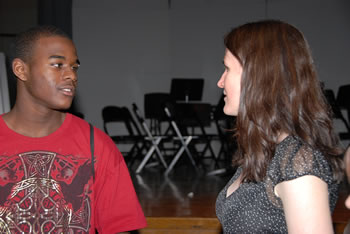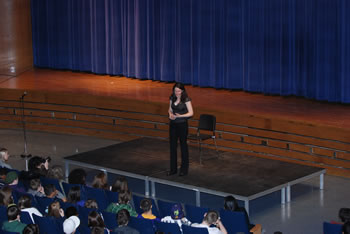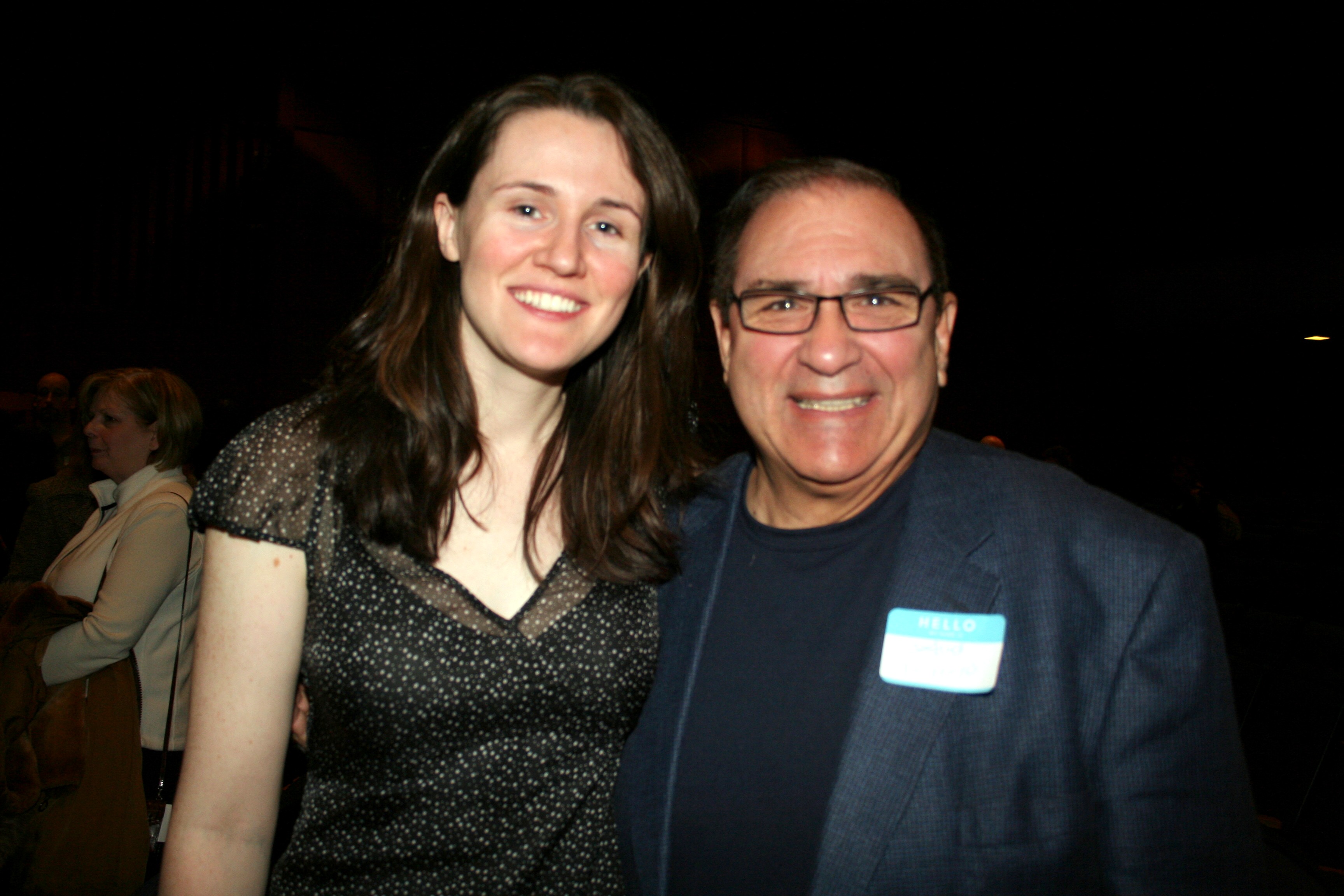Liz Murray Captivates Huntington

Liz Murray stood for an hour on a small platform erected in the orchestra pit of the Huntington High School auditorium Monday morning and captivated an audience of more than 1,200 teenagers, teachers and community leaders with a message that was at times intensely personal and at others incredibly positive and uplifting.
Ms. Murray said she came to Huntington to discuss “possibilities,” recounting her life story, which was made into a Lifetime television movie, “From Homeless to Harvard,” including growing up with drug addicted parents, going hungry at night and riding the “D” train all night because it traveled underground and she could sleep in its warm cars.
While students and teachers sat glued to their seats on the auditorium’s main level, the district’s central administrative team, PTA officials, Huntington School Board members and community dignitaries, including town Supervisor Frank Petrone occupied the balcony area.
 The visit was sponsored by the district’s Arts-in-Education committee. Ms. Murray, who earned an undergraduate degree at Harvard, where she has also been accepted to grad school, gave a no-holds barred talk, describing how her parents were drug addicted, often shooting up right in front of their two daughters, “with bloody arms and eyes-popping out.” A monthly welfare check bought about $30 worth of food that was gone within a few days with the balance devoted to purchasing more drugs.
The visit was sponsored by the district’s Arts-in-Education committee. Ms. Murray, who earned an undergraduate degree at Harvard, where she has also been accepted to grad school, gave a no-holds barred talk, describing how her parents were drug addicted, often shooting up right in front of their two daughters, “with bloody arms and eyes-popping out.” A monthly welfare check bought about $30 worth of food that was gone within a few days with the balance devoted to purchasing more drugs.
“My mother sold our Thanksgiving turkey that was given to us by a church,” Ms. Murray said about her mother’s insatiable appetite for drugs, which led to her selling things like the family toaster and even her shoes.
Yet, Ms. Murray said she was never angry. Depressed? Yes, but not angry. She knew her parents loved her, but their drug addiction made normal family life impossible. “I wore the label of victim,” Ms. Murray said. It became easy to cut school for days and weeks at a time. Her report card was basically one big “F” as she made compromises that justified in her own mind the poor choices she was making.
The family apartment was a filthy mess, with broken windows and rain and snow coming inside. She became homeless at 15 and sometimes ate ice cubes in place of real meals. A group of friends became a type of family unit for Ms. Murray. She would often stay with others and saw stints in foster homes.
 After her mother contracted HIV, Ms. Murray watched her slowly disintegrate. She started spending five or six hours a day with her mother in the hospital, but over time the amount shriveled, until it completely evaporated.
After her mother contracted HIV, Ms. Murray watched her slowly disintegrate. She started spending five or six hours a day with her mother in the hospital, but over time the amount shriveled, until it completely evaporated.
When Ms. Murray walked out of her mother’s room on Thanksgiving Day saying she would be right back, it was the last time mother and daughter saw each other alive. A month later her mother died. When she was buried in a plain pine box the day after Christmas, something clicked. “We take life for granted,” she told the Huntington crowd. “It’s easy to make excuses and put things off. But, life doesn’t wait for anyone.”
Sitting with a group of complaining friends after her mother was laid to rest Ms. Murray said the change in her life was immediate. “It’s either resentment or gratitude,” she said. “I chose gratitude.”
As her friends went on with their negativity, Ms. Murray said she blurted out, “My mom’s dead! Look at us; two hands, two feet. I’m going to school!”
 As it turned out, it wasn’t that easy. She was closing in on 17 years of age and she had earned exactly one high school credit. She interviewed for admission at various alternative high schools in New York City only to get rejected from all of them. Until one day she had a self-described “mini-breakdown” in midtown Manhattan and had to decide whether to go through with still another interview, this time at Humanities Preparatory Academy or meet up with friends for pizza. It was what Ms. Murray calls her “what if?” moment.
As it turned out, it wasn’t that easy. She was closing in on 17 years of age and she had earned exactly one high school credit. She interviewed for admission at various alternative high schools in New York City only to get rejected from all of them. Until one day she had a self-described “mini-breakdown” in midtown Manhattan and had to decide whether to go through with still another interview, this time at Humanities Preparatory Academy or meet up with friends for pizza. It was what Ms. Murray calls her “what if?” moment.
She decided to go to the interview, met a teacher there named Perry, who became a powerful mentor and was accepted into the school. Still homeless, she started studying and then some, taking a full load of classes during the day, attending still more at night and even on Saturdays. Ms. Murray completed an entire year’s worth of credits in a single semester, earning a 96 average and finishing a four year high school program in just two years.
Still without a permanent place to live and still going hungry most days, she applied for various small scholarships. Then she had a whirlwind day. Ms. Murray had interviews with the New York City welfare office, Harvard and The New York Times.
At the presentation in the Huntington High School auditorium, Ms. Murray laughed while recounting how the welfare office meeting didn’t go very well, but she was a hit with Harvard and a conference room full of NYT officials, who awarded her a scholarship worth $12,000 annually for four years.
 The New York Times scholarship is still a source of pride, as Ms. Murray pointed out she was one of just six recipients out of 3,000 applicants. When the paper ran a story about the award winners in its Metro section, readers “came out of the woodwork” after learning of Ms. Murray’s life story, showing up at her school to offer assistance.
The New York Times scholarship is still a source of pride, as Ms. Murray pointed out she was one of just six recipients out of 3,000 applicants. When the paper ran a story about the award winners in its Metro section, readers “came out of the woodwork” after learning of Ms. Murray’s life story, showing up at her school to offer assistance.
She asked Huntington students to think about “What really separates you from the people you admire other than the work?” She urged students to consider the possibilities during their own “what if” moment. “What if you made it different from this moment forward?” she asked.
Many students were moved to tears and a long line of teenagers seeking a few seconds of Ms. Murray’s time formed at the end of presentation. She made a connection that was strong and her message hit some people right between the eyes.
She urged Huntington students to take command of their lives and strive for success, not letting any negative forces get in the way. “Sometimes when you don’t know how difficult something is, you will go right ahead and do it,” Ms. Murray said.
An afternoon presentation was held for the seventh and eighth graders in the J. Taylor Finley Middle School gym. The message was well received there, too.
“The message speaks for itself,” Superintendent John J. Finello said. “It’s hard to imagine a more powerful presentation.”
All graphics, photographs, and text appearing on the Huntington Public Schools home page and subsequent official web pages are protected by copyright. Redistribution or commercial use is prohibited without express written permission. Comments or Questions? email the Public Information Office